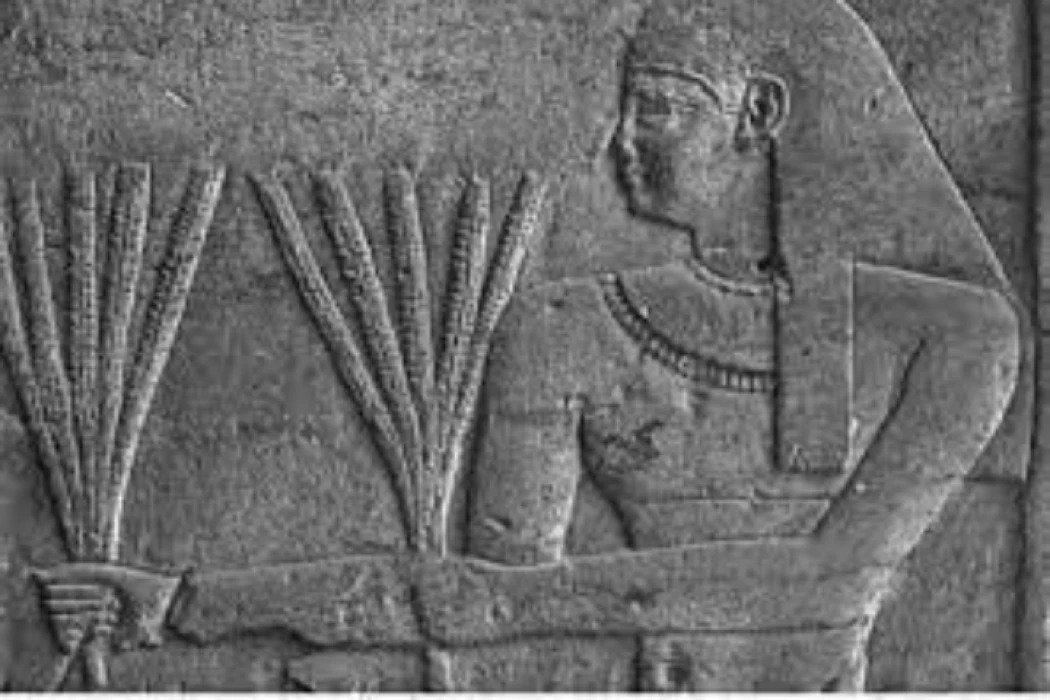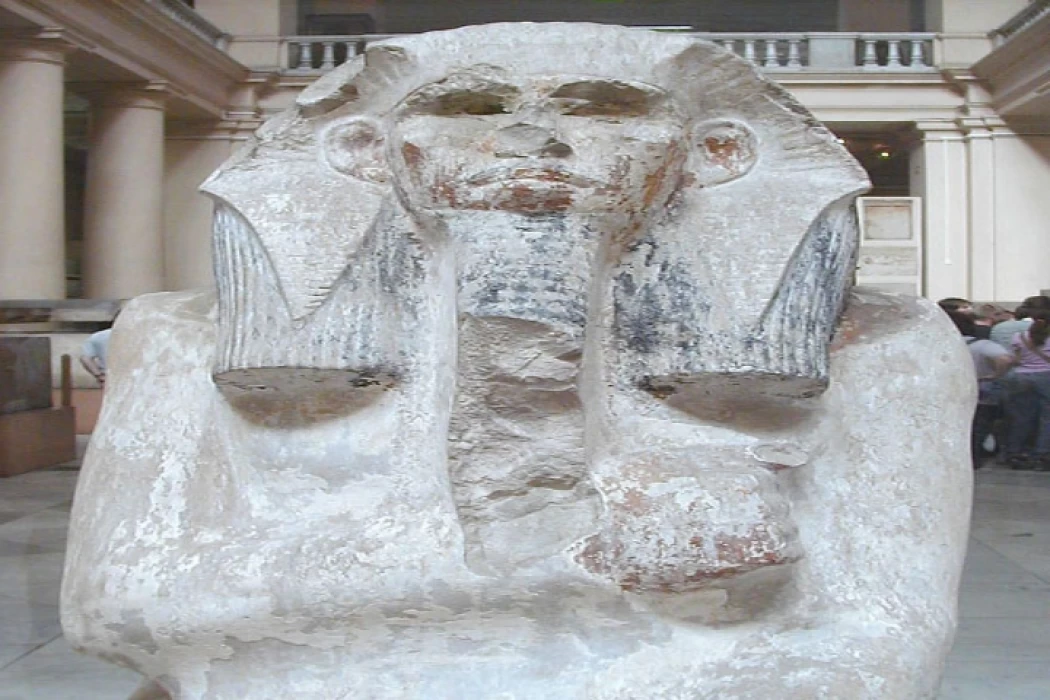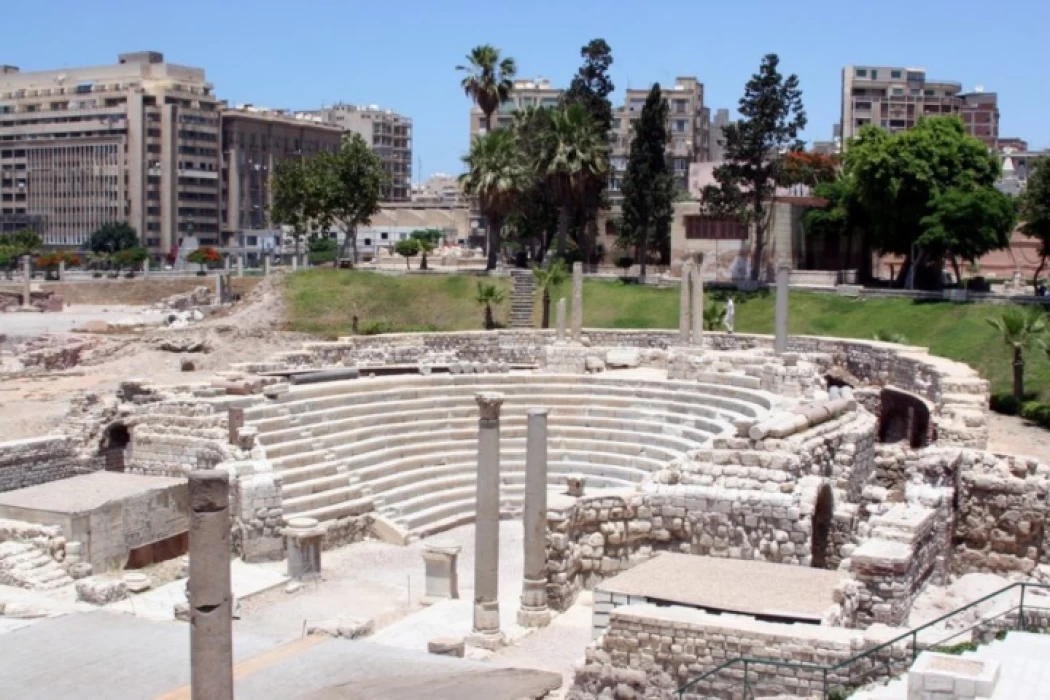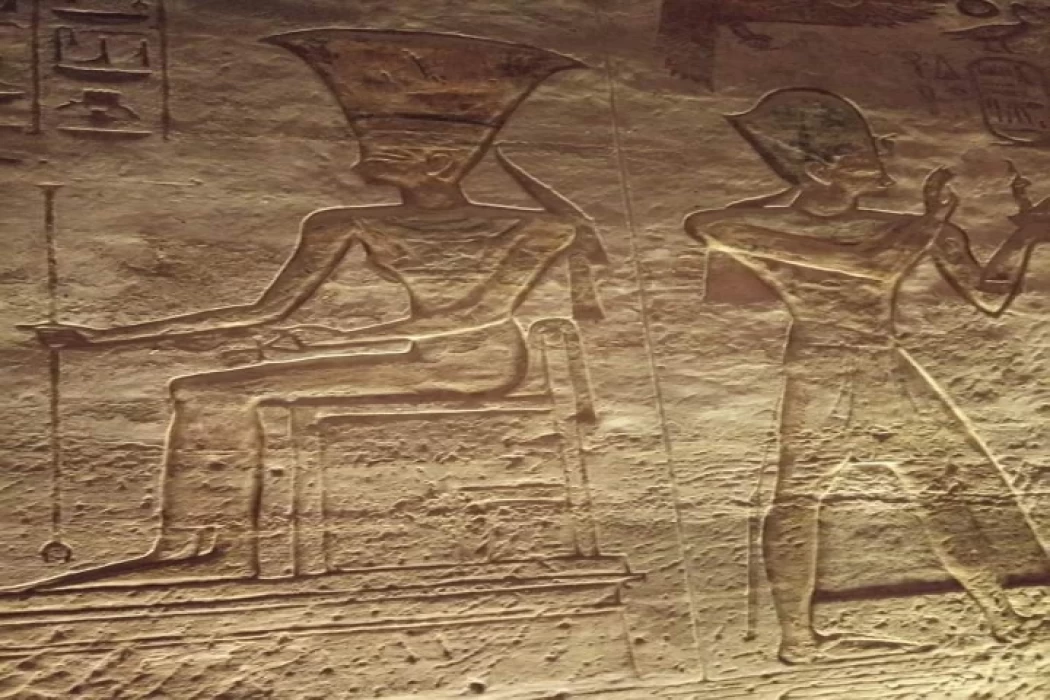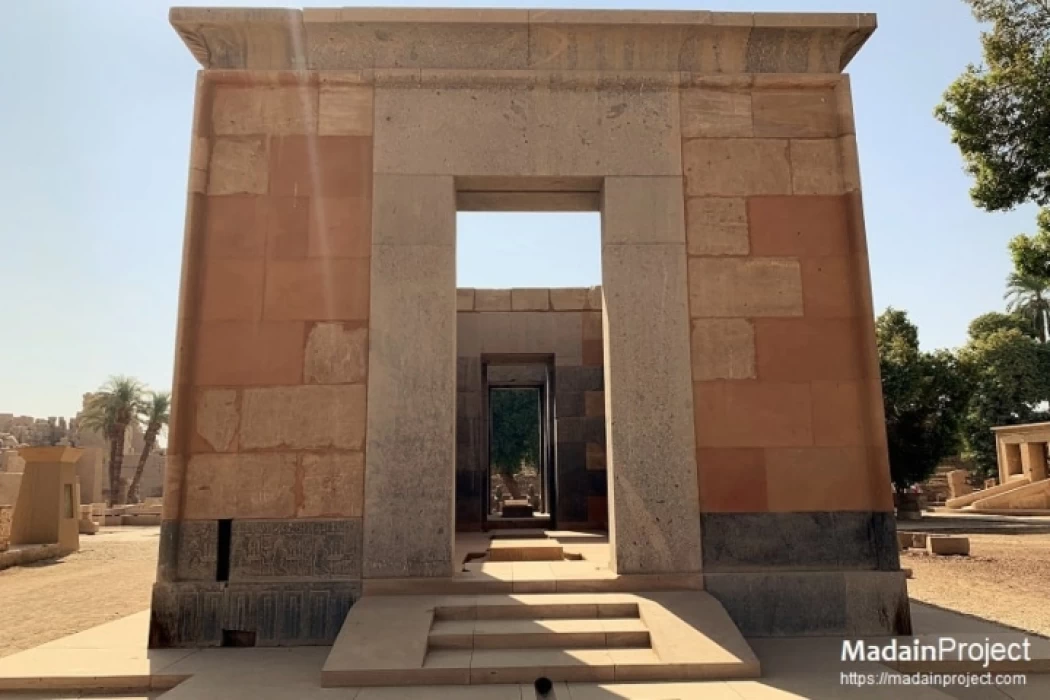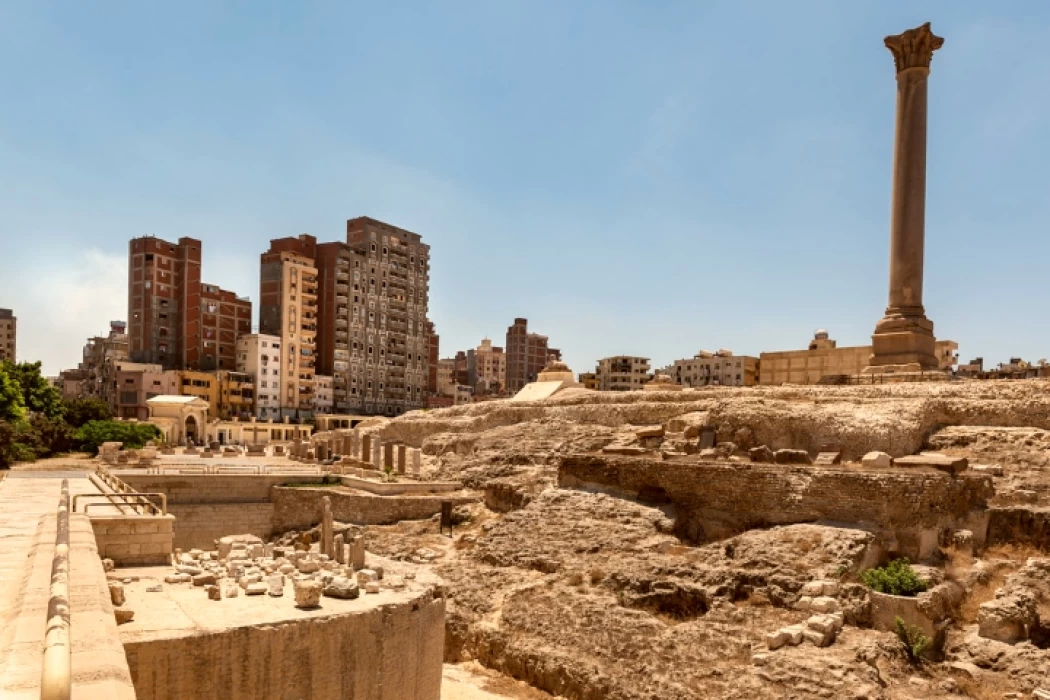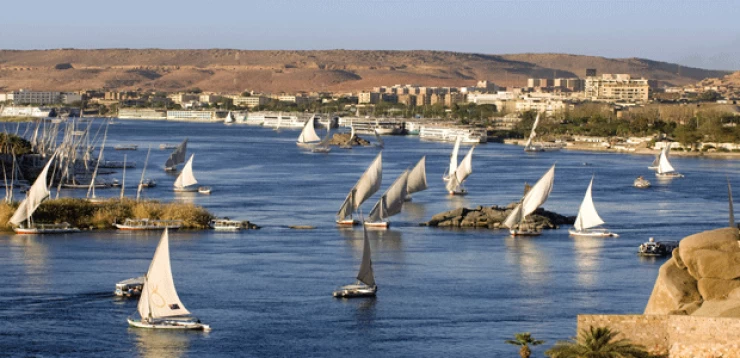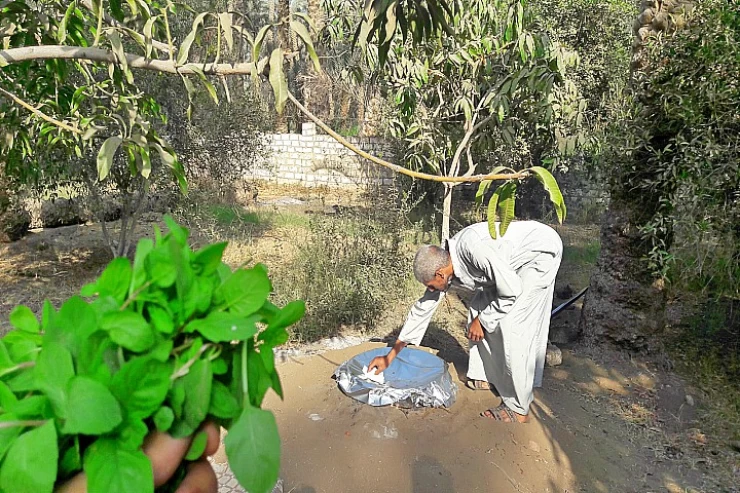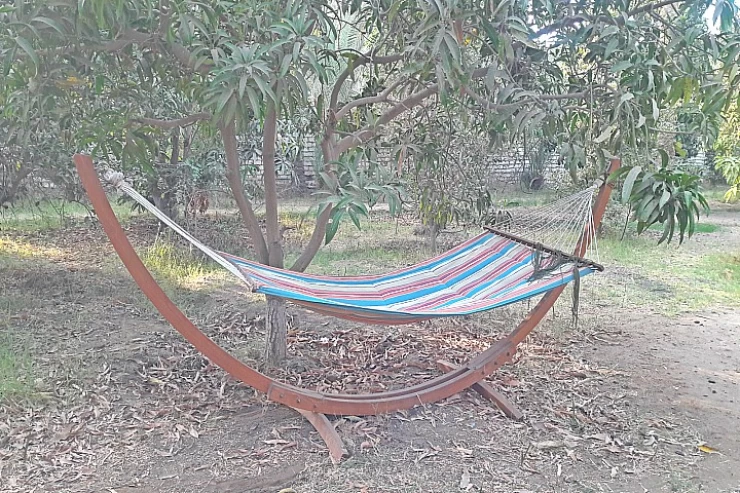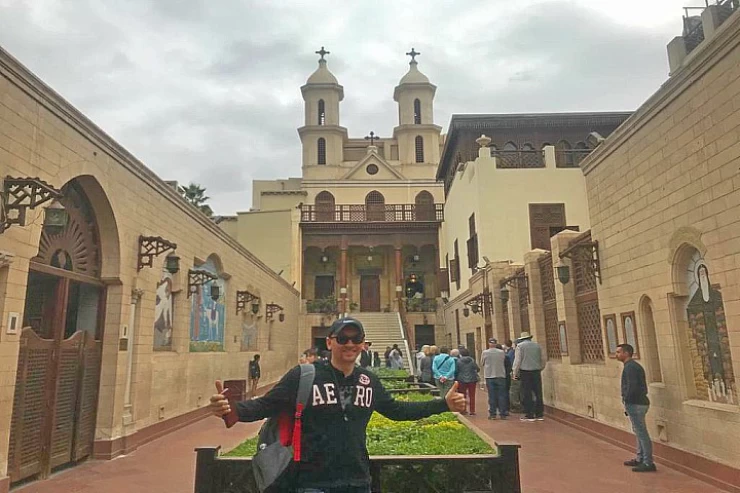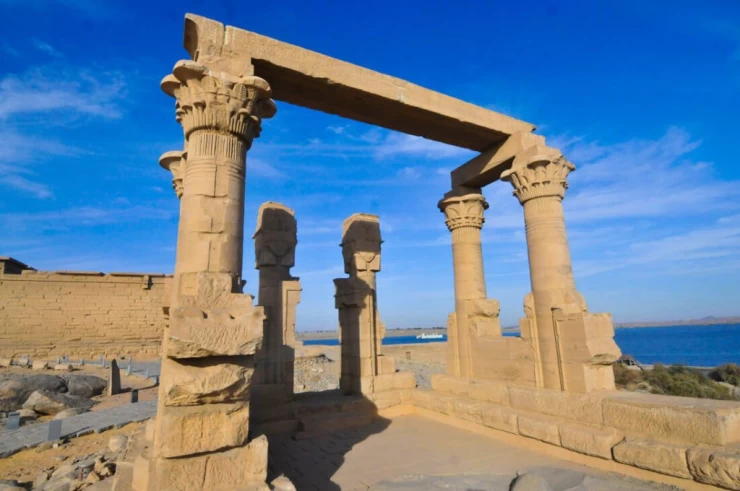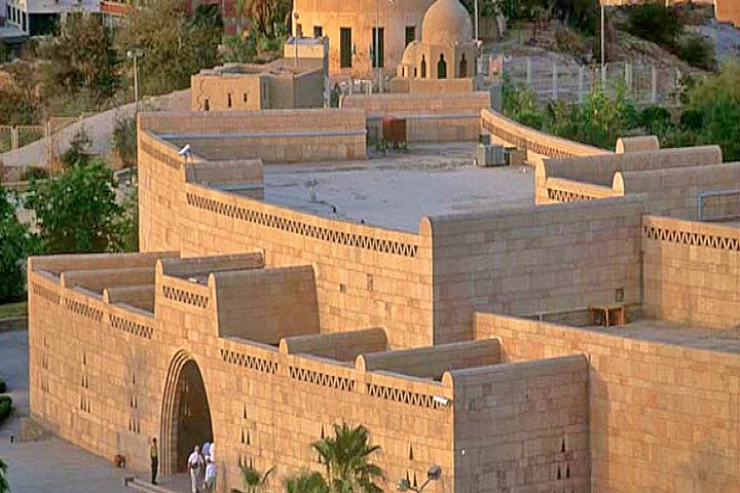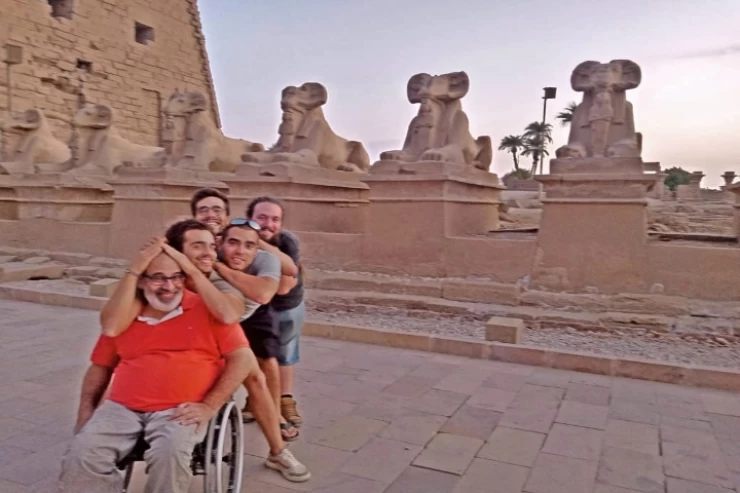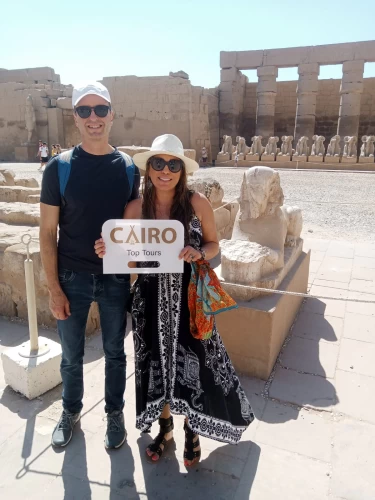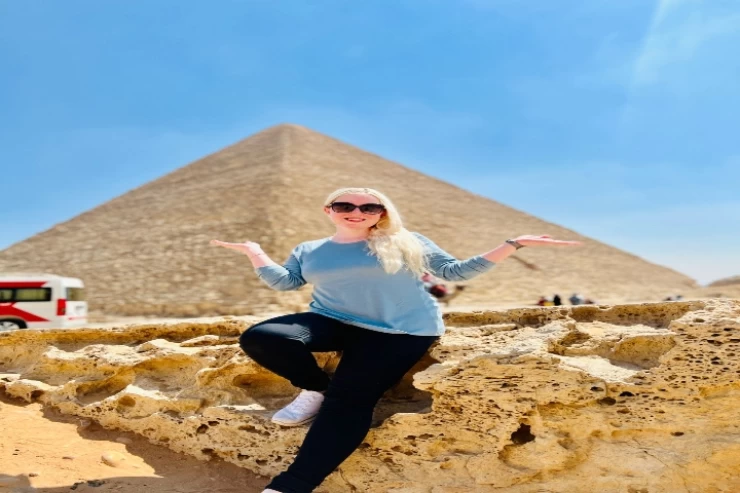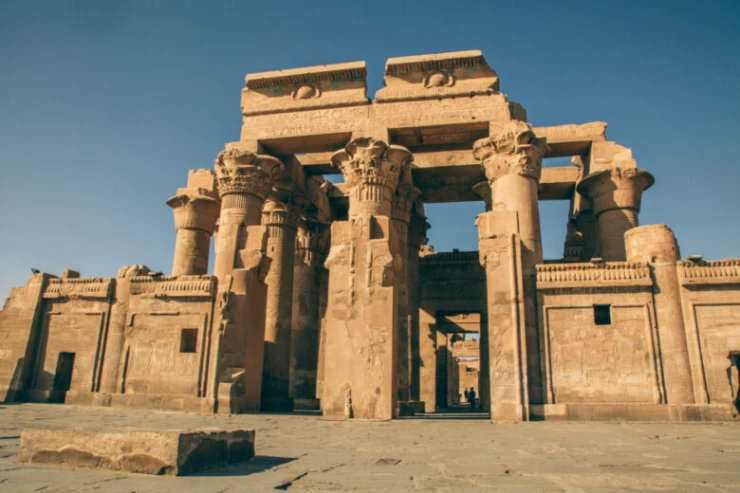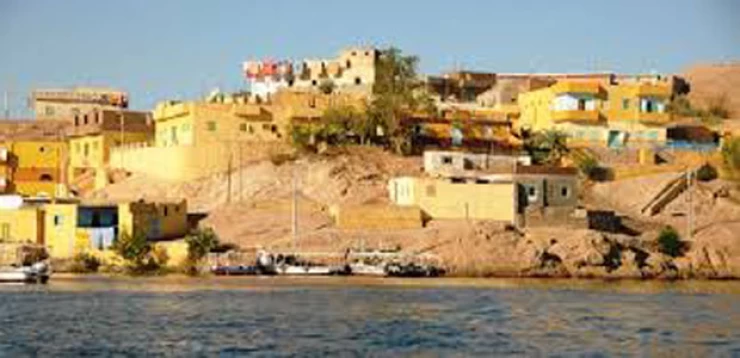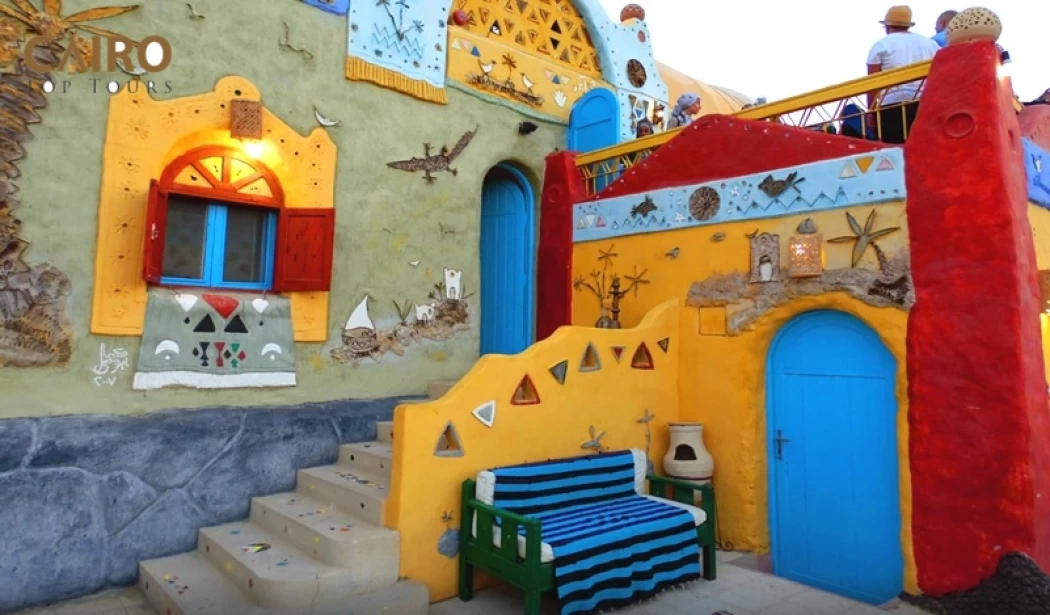
The Nubian Village
Why tourists prefer Nubian villages as a tourist destination in Aswan is a question answered by the Nubian people by the nature of their conditions and homes located in the southernmost part of Egypt, where aspects of their customs and traditions inherited from their ancestors have also emerged and become a modern tourist heritage that draws the attention of tourists and attracts them to visit this charming environment and nature.
"The Seventh Day" highlights tourism in Nubian villages, and reviews the most prominent elements that have made it at the forefront of the types of tourism that are indispensable for any foreign tourist visiting Aswan in southern Egypt, through the statements of Abdel Nasser Saber, a tour guide of German nationality and former captain of tour guides.
Abdel Nasser Saber said that the trip to the Nubian villages in Aswan falls under the name of social trips, which is a cultural trip primarily in which the passion of a tourist eager to learn about the places he visits is satisfied, and then it is a trip to enjoy nature and relax.
He added that the trip to the Nubian village may be by felucca if the village is nearby or by "motor boat", and it starts from the reception of the steamer and the guide helps tourists during the trip to provide a hearty informational meal throughout the Nile trip to the Nubian village.
Abdel Nasser Saber explained that the Nubian village is different from the traditional Egyptian village due to its special architectural system, in which the Nubian man used raw materials from the surrounding environment and built beautiful houses with them, there were domes and basements of mud bricks that protect the rooms from the strong heat of the sun.
The Nubians are a Nilo-Saharan-speaking ethnic group, indigenous to the area currently located in northern Sudan and southern Egypt. Their origin goes back to the first inhabitants of the middle Nile Valley, which is believed to be one of the first cradles of civilizations in the world. The Nubians in the southern valley of Egypt are culturally and ethnically different from the Egyptians, although they intermarried with members of other ethnic groups, especially Arabs. Nubians speak Nubian as a mother tongue, which is part of the languages of northeastern Sudan, as well as Arabic as a second language.
Neolithic settlements have been found in the central Nubian region dating back to 7000 BC, as Wadi Halfa is believed to be the oldest settlement in the middle Nile Valley. From time to time, areas of Nubia, especially Lower Nubia, were part of ancient Pharaonic Egypt, and at other times it was a rival state representing parts of Meroe or the kingdom of Kush. By the time of the reign of the Twenty-Fifth Dynasty (744 BC-656 BC) the whole of Egypt was united with Nubia, extending south to what is today Khartoum. However, in 656 BC, the original twenty-sixth dynasty regained control of Egypt. The ancient Nubians knew warriors, they were famous for their skill and accuracy in using a bow and arrow. In the Middle Ages, the Nubians converted to Christianity, founded Three Kingdoms: nubia in the North, Al-maqara in the center, and Alula in the South, and then converted to Islam during the Islamization of the Sudan region.
The Nubians residing in Egypt Today settle mainly in southern Egypt, especially in Kom Ombo and Nasr Nubia north of Aswan, and in large cities such as Cairo, while the Sudanese Nubians settle in northern Sudan in the area between the city of Wadi Halfa at the Sudanese-Egyptian border and the Dabah area. Some Nubians were forcibly relocated to Khashm El-Kurba and New Halfa after the construction of the High Dam in Egypt, which flooded the land of their ancestors. In addition, a group called medub lives in North Darfur, a group called Birgid lives in Central Darfur, and several groups known as nubio live in the hills of North Kordofan in Haraza and a few villages in the northern Nuba Mountains in South Kordofan state.
The main Nubian groups in the Nile from North to South are: the Kenzi (Matuk-speaking Kenzi), fadika (Nubian-speaking), halvawi (Nubian-speaking), Sukkot (Nubian-speaking), Mahasa (Nubian-speaking), and danagla (andandi-speaking).
History,
The prehistoric history of Nubia dates back to the Paleolithic period about 300,000 years ago. By about 6000 BC, the peoples of the region had developed an agricultural economy. In their history, they adopted the Egyptian hieroglyphic system. The ancient history of Nubia is classified according to the following periods: the civilization of Group a (3700 - 2800 BC), the civilization of Group C (2300 - 1600 BC), the civilization of Kerma (2500 - 1500 BC), the contemporary Nubians of the New Kingdom (1550 - 1069 BC), the Twenty - Fifth Dynasty (1000 - 653 BC), Napata (1000 - 275 BC), the Meroe (275 BC - 300/350 ad), makuria (340 - 1317 ad), nobatia (350 - 650 AD), Alodia (about 600-1504 ad).
Archaeological evidence has established that population settlements appeared in Nubia as early as the early modern period and from the fifth millennium BC onwards, while there is "no evidence, not even weak evidence" of human presence in the Egyptian Nile Valley during these periods, and the difficulties of preserving the archaeological site may be a reason for this.
Many scholars have argued that the African origins of Egyptian civilization derive from pastoral societies that emerged in both the Egyptian and Sudanese regions of the Nile Valley in the fifth millennium BC.
Numerous biological anthropological studies have shown a close biological kinship between the pre-dynastic southern population and the early Egyptians and Nubians.
Frank Yurko (1996) noted that depictions of pharaonic icons such as royal crowns, Horus Falcons, and scenes of victories were concentrated in the Naqada civilization of Upper Egypt and the civilization of Group A in Lower Nubia, and also explained that "Egyptian writing originated in Upper Egypt during the Naqada civilization and in the civilization of Group A in Lower Nubia and not in the Delta civilizations where direct contact with Western Asia began [which] invalidates the argument of Mesopotamian influence".
Christopher Eret stated in 2023 that existing archaeological, linguistic, biological, and genetic anthropological evidence attributed the founding sites of ancient Egypt to long-existing dynasties in northeast Africa that included Egypt, Nubia, and the northern Horn of Africa.
The linguistic affinity of the first Nubian civilizations is uncertain. Some research has indicated that the first inhabitants of Nubia during the C-Group civilization and the Kerma civilization spoke languages belonging to the Amazigh and Cushitic branches, respectively, of the Afro-Asian family. On the other hand, more recent research indicates that the peoples of the Kerma civilization spoke Nile-desert languages specific to the eastern branch of Sudan, and the peoples of the civilization of Group C located in the North spoke the Cushitic language, followed by the first speakers of the Nubian language and their language belongs to another branch of the East Sudanese languages, one of the races of the Nile-desert languages. The Victory Monument of the 4th century AD built in memory of the Axum King Ezana contains inscriptions describing two distinct groups of the population in ancient Nubia: a "red" population, and a "black" population.
Although Egypt and Nubia have a common - pre - dynastic and Pharaonic history, the two dates diverge with the fall of ancient Egypt and the conquest of Egypt by Alexander the Great in 332 BC. At this stage, the land between the first and sixth Ganges of the Nile was known as Nubia.
The Persians initially conquered Egypt and named it mizrabania (Persian state) Mudria, and two centuries later it was conquered by the Greeks and after them the Romans. However, during the last period, the Kushites formed the kingdom of Meroe, which was ruled by a series of legendary kandakas or Queens. It is mythologically claimed that the kandaka (Queen) of Meroe managed to intimidate Alexander the Great and forced him to retreat using a great army of elephants, while historical documents indicate that the Nubians defeated the Roman Emperor Augustus Caesar resulting in a peace treaty serving the interests of Meroe. The kingdom of Meroe also defeated the Persians, and later Christian Nubia defeated the invading Arab armies on three different occasions resulting in a peace treaty between them named after the Treaty of Albakt, which lasted 600 years, the longest treaty in history. The Christian kingdom of Nubia fell at the turn of the XV century, which led to its complete Islamization, and reunification with Egypt under the Ottoman Empire, the Muhammad Ali Dynasty, and British colonial rule. After Sudan's independence from Egypt in 1965, the Nuba and the Nubian people split between southern Egypt and northern Sudan.
Modern Nubians speak the Nubian languages, which are East Sudanese languages that are part of the Nilo-Saharan language family. The existence of the ancient Nubian language has been proven since the eighth century AD, and it is the oldest recorded language in Africa from outside the Afro-Asian language family.
Nubia consists of four areas with diverse landscapes and plantings. The Nile River and its valley pass through the northern and central parts of Nubia, which allows the existence of irrigated agriculture. Western Sudan is a mixture of agricultural village life and Bedouin life. Eastern Sudan contains primarily nomads as well as a few cultivated and irrigated lands. Finally, there is the fertile pastoral region in the south where the largest agricultural communities in Nubia are located.
Nubia was dominated by Kings from clans that controlled gold mines, and traded exotic and rare goods (ivory, animal skins) coming from other parts of Africa to Egypt through Nubia.
The Nubians speak the Nubian language and it is divided into two main parts, the Nubian Nilotic language and the Nubian language of the mountains. Besides the Nubian language, the current population speaks Arabic fluently with other languages such as English, French, and Italian due to their mixing with tourists and foreign visitors.
The ancient Nubian language is preserved in about 100 thousand historical documents and manuscripts, mostly of a Christian religious character, in an alphabet believed to have been composed jointly with a relatively diverse Greek alphabet, with three extensions from Coptic, and three unique to old Nubian-derived from the Meroitic language. These documents range in date from the 8th to the 15th century AD.
Nubia country in Egypt is divided into three regions
The treasure zone
Qursha-the Strait is divided into two parts (treasures - Arabs) on the East for the Aswan road and the railway marwao - Maria - Jurf Hussein - Kalabsha - abhor - Muharraq – Al - Sayala - kashtamna East - kashtamna West - Deka - dahmet - amberkab - dabud and on the West for the Aswan road and the railway qursha - Alaqi qorta II - qorta I-qorta III on the East for the Aswan road and the railway .
The Arab region is part of the Strait - Wadi Al - Arab-crosco - senqari Al - Sabwa-shatarma-al-Malki, from the east side of the Aswan road and the railway.
Diwan-Al-Durr, tangle-Ibrim-Quta - El Geneina, Shabak - mussels - enaiba - arena - tushki West - tushki East Abu Simbel - Qastal - first Plana - second plana - third Plana - adandan - Thomas and Afia-from the east to Aswan road and railway Dar es Salaam has a mixture of treasures and fadijat east of Aswan tuwaisa road, most of its inhabitants are from Daboud Al-harbiab west to Aswan road. Dar Al-Kunooz has a group of treasures on the west side of Aswan-Abu al-Rish road, it has a group of treasures on the east side of Aswan-Al-fawwaza road, it has a Nubian group that migrated with the raising of the reservoir in 1933, nag Abu Dhafer, Edfu, it has a branch of the haknab Kenzi tribe from qarsha west of Aswan road and the railway .
The village of West Aswan, which is considered the largest Nubian village-Al - Shalal - Aswan island (Swan Arti) - Ezbet al - Askar and contribution - tanqar - Jabal tuqq - Berber - Al - multi-Ezbet Al - Manshiyya - Sohail Island - West Sohail - West Khazzan Gharb - Hisa island - Manshiyya Al - Nuba - Beja - Ezbet Al-hudud - Ezbet Al - Dabodiya - Al - Karr - arashkul-Tayab - Al-Masi Todd-and areas with Nubian communities such as Al-hasaya-Al-Jazira-Awad Island-Sheikh Harun-al-Seel-Al-Khazzan-Kima-mahmudiya-friendship.
Population areas located in the Sudanese administrative division
Wadi Halfa or ancient Halfa is located in the far north of Sudan in the northern state, it is one of the ancient cities and was the center of the English forces in Sudan during the occupation period. Its people speak the Nubian language, and this is probably the name of Halfa, which is named after several cities among the Amazigh in North Africa, as is the case of the Halfaouine neighborhood in Tunisia, for example. It was full of many important Nubian and pharaonic monuments until it was submerged in the waters of the High Dam Lake and the most important monuments were transferred to Abu Simbel and the National Museum of Sudan, namely the temples of Buhain, semna East, semna West and the Cathedral of Fars. Its administrative boundaries extend south to the villages of Dal and serkmeto in the far north of the scut.
The silence is called Nubian, pronounced (breaking the Seine, the silence of the cave and the annexation of the Wau), for a large area located south of Wadi Halfa and extends to the areas of the south with many ancient and relatively modern historical monuments and with some Islamic monuments, the only city is the city of Hebrew, and there are also Sidi Akasha and Sheikh Idris Dome mosques in the area, and the inhabitants of those areas speak the Nubian language almost identical to the language of the inhabitants of Halfa.
The shrine of Sheikh Idris in Elfoun
The MAHS are one of the large Sudanese Nubian tribes and they inhabit the home of the MAHS, and most of the states of Sudan, such as the northern state, the Nile River, the island state, Khartoum, the White Nile, parts of the lining, Kassala, the Red Sea, Gedaref, Kordofan.
Al-muhass was famous for spreading Islamic Science and the Holy Quran, and their sheiks were famous during the days of the Funj state, including Idris, Dar Al-Arbab, Arbab Al-khushan, khojli Abu al-jazz, and Imam Abu janitor.
The word dungla is derived from dungl (with the addition of the letter D, the consonance of the noun, and the raising of the rhyme), which is a red brick in the Nubian languages, and it was so named because its buildings were built of red bricks, unlike the neighboring ones built with adobe bricks-raw bricks (i.e., sun-dried clay bricks before burning them). some say that dungla is a Nubian word consisting of two syllables, namely "Dungi", meaning money, and"no" (Nafia), meaning lack of money, and thus the word Dungi-not refers to a place "without money". There is a third version that says that the word is a compound of two words, namely " DA "meaning house, and" say "(including rhyme) meaning heart, or center, so the meaning of the name is"heart of the home". A fourth account attributes the name to a Nubian king who ruled the region called Dingle.
The word is also called for everything strong and solid, and that's why some attribute the name of the city to the character of its king dunql or, do - in - say, in Nubian, meaning the strong resident in a large castle on the Nile, and some even believe that dunqla is a corruption of the word Castle House (or castle house) relative to a large castle in the place overlooking the Nile.
Latest Articles
Admin
Neper God Of Grain
Neper was the deity of grains, particularly cereals that were important in Ancient Egypt, such as wheat and barley. It was stated that he foretold when the crops would grow, be harvested, and disappear.
Admin
Djoser
Djoser was an ancient Egyptian pharaoh of the 3rd Dynasty during the Old Kingdom and was the founder of that epoch. He is also known by his Hellenized names Tosorthros (from Manetho) and Sesorthos (from Eusebius). He was the son of King Khasekhemwy and Queen Nimaathap, but whether he was also the direct successor to their throne is unclear. Most Ramesside king lists identify a king named Nebka as preceding him, but there are difficulties in connecting that name with contemporary Horus names, so some Egyptologists question the received throne sequence. Djoser is known for his step pyramid, which is the earliest colossal stone building in ancient Egypt
Admin
Kom Al Dikka Alexandria
Kom El Deka, also known as Kom el-Dikka, is a neighborhood and archaeological site in Alexandria, Egypt. Early Kom El-Dikka was a well-off residential area, and later it was a major civic center in Alexandria, with a bath complex (thermae), auditoria (lecture halls), and a theatre.
Admin
The God Anuket
Anuket, in Egyptian religion, the patron deity of the Nile River. Anuket is normally depicted as a beautiful woman wearing a crown of reeds and ostrich feathers and accompanied by a gazelle.
Admin
The Red Chapel of Hatshepsut
The Red Chapel of Hatshepsut or the Chapelle rouge was a religious shrine in Ancient Egypt. The chapel was originally constructed as a barque shrine during the reign of Hatshepsut. She was the fifth pharaoh of the Eighteenth Dynasty from approximately 1479 to 1458 BC.
Admin
The Serapeum of Alexandria
The Serapeum of Alexandria in the Ptolemaic Kingdom was an ancient Greek temple built by Ptolemy III Euergetes (reigned 246–222 BC) and dedicated to Serapis, who was made the protector of Alexandria, Egypt. There are also signs of Harpocrates. It has been referred to as the daughter of the Library of Alexandria.
